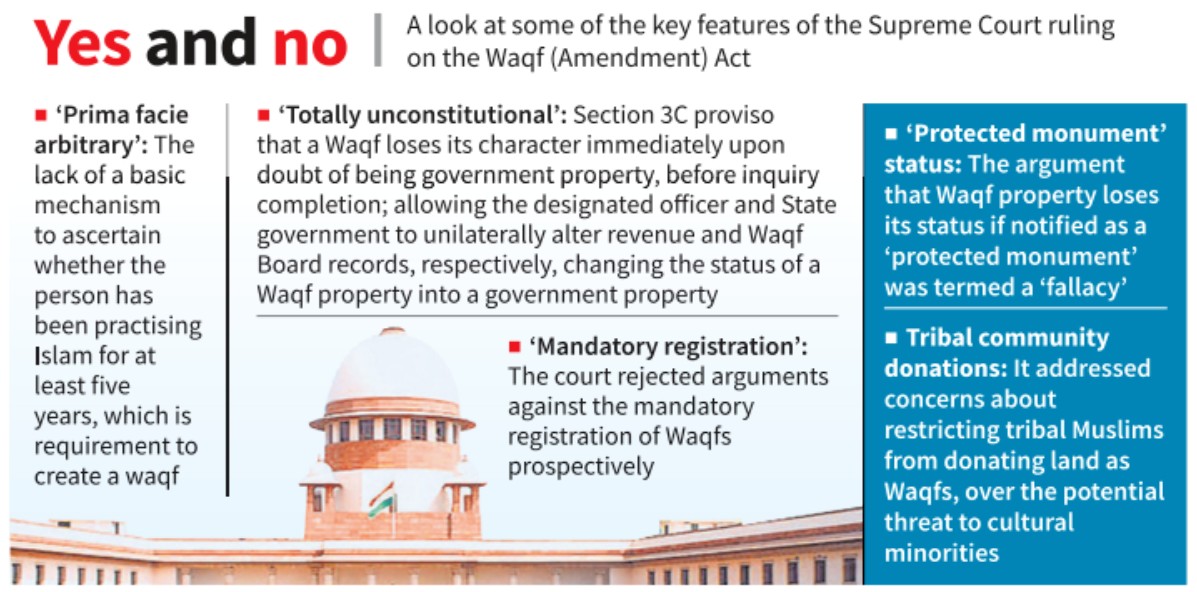Introduction
The Waqf (Amendment) Act, 2025, passed by Parliament earlier this year, faced widespread opposition from political leaders, religious organisations, and civil society. Over 65 petitions were filed, challenging its constitutional validity. On September 15, the Supreme Court issued an interim order staying several key provisions, particularly those expanding the powers of district collectors, imposing a five-year Islam practice condition for creating a waqf, and capping non-Muslim representation in Waqf boards. At the same time, the Court upheld other significant changes such as the removal of “waqf-by-user” and the applicability of the Limitation Act. This selective intervention reflects the judiciary’s cautious approach in balancing equity, religious freedom, and governance.

Why is the Supreme Court’s interim stay significant?
- First major judicial intervention: The SC’s order is the first substantive check on the Waqf (Amendment) Act, 2025 since its passage.
- Large-scale impact: With nearly 65 petitions filed, the matter affects thousands of properties and the rights of the Muslim community across India.
- Balance of powers: The Court flagged violation of the separation of powers doctrine by preventing revenue officers from adjudicating property titles.
- Guardrails against misuse: While not striking down the Act, the Court has added interim safeguards to prevent dispossession and misuse of powers.
What powers of District Collectors were stayed?
- Section 3C inquiry power: District Collectors could declare that land claimed as waqf is government property. The SC stayed the clause that made waqf status cease immediately upon inquiry.
- Arbitrariness highlighted: Entrusting title determination to a revenue officer was held to be prima facie arbitrary.
- Safeguard applied: Waqf properties will retain their status until adjudicated by a Waqf Tribunal. However, no third-party rights can be created until final resolution.
How did the Court deal with non-Muslim representation in Waqf Boards?
- Capping membership: Central Waqf Council (22 members) shall not have more than 4 non-Muslims; State Waqf Boards (11 members) shall not have more than 3 non-Muslims.
- Community rights upheld: This ensures that the Muslim community’s right under Article 26 to manage religious affairs is not diluted.
- Avoiding ambiguity: The SC clarified numbers to prevent misinterpretation of the law.
What about the ‘five years of practising Islam’ rule?
- New definition of waqf: The 2025 Act required proof of practising Islam for five years to create a waqf.
- Provision stayed: SC stayed this rule until the government frames rules and mechanisms for proof.
- Judicial caution: The Court noted concerns of arbitrariness and discrimination, but also recognised historical misuse of waqf as a tool to evade creditors.
Which provisions were not stayed?
- Abolition of ‘waqf by user’: The Court upheld its removal, citing misuse to encroach upon government lands.
- Applicability of the Limitation Act: Waqfs must now act within statutory limitation periods. This was upheld as removing previous discrimination.
- Registration compliance: SC emphasised that waqfs had 102 years (since 1923) to register, hence claims of arbitrariness were weak.
What is the larger constitutional and governance context?
- Presumption of constitutionality: Laws passed by Parliament carry weight until struck down.
- Balancing equities: The SC avoided blanket suspension, staying only contentious clauses.
- Protection of minority rights: Ensures Article 26 freedoms are not eroded.
- Preventing property misuse: Legislative intent to protect government property and curb misuse was acknowledged.
Conclusion
The Supreme Court’s interim order on the Waqf (Amendment) Act, 2025 reflects a nuanced judicial approach—protecting religious freedoms while respecting legislative authority. By drawing constitutional boundaries for state power and emphasising procedural fairness, the Court has reinforced its role as a guardian of equity and minority rights. The final verdict will have long-lasting implications for governance of religious endowments and minority trust in legal institutions.
PYQ Relevance:
[UPSC 2019] What are the challenges to our cultural practices in the name of secularism.
Linkage: The Waqf (Amendment) Act, 2025 has been challenged for allegedly curbing the Muslim community’s right under Article 26 to manage its religious endowments, showing how state intervention can threaten cultural practices. The Supreme Court’s interim stay on provisions like non-Muslim majority in Waqf Boards and “five years of practising Islam” directly reflects the tension between secular governance and religious autonomy. Thus, the case exemplifies the broader challenge of balancing secularism with protection of cultural practices, as asked in the 2019 question.
Get an IAS/IPS ranker as your 1: 1 personal mentor for UPSC 2024

